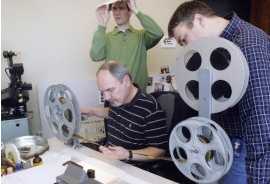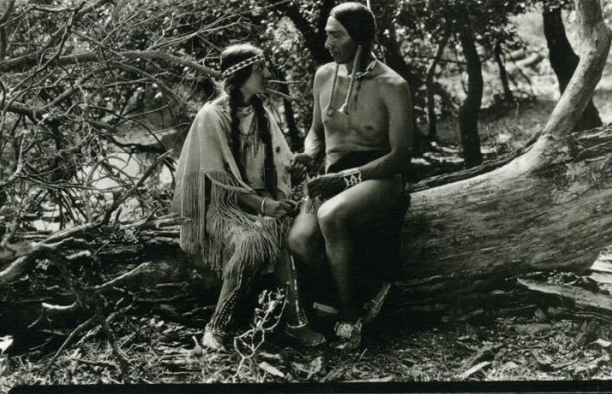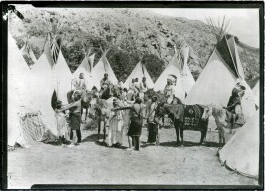Jordan Wright
August 28, 2012
Special to Indian Country Today Media Network – Magazine feature
How a silent film featuring an all-Native cast came to be made, lost (seemingly forever), discovered nearly a century later (in shambles), then restored and shown to the cast’s descendants is one of the most fascinating stories in the annals of American filmmaking. The Daughter of Dawn, which had its world premiere in June at the deadCENTER Film Festival in Oklahoma City, may be the only all-Native cast silent film ever made.
In the autumn of 1919 Norbert Myles was hired to direct a film for Richard Banks, owner of the fledgling Texas Film Company. Banks, who had written the story for his new project, was looking to make an adventure film in Oklahoma. He had met Myles a few years earlier on a California movie set and was impressed by the ambitious upstart. Myles, who had been a vaudevillian, a screen actor and sometime Shakespearean actor, had fallen out of favor in Hollywood and had turned to screenwriting and directing.
Banks drew on his 25 years of experience living among the Indians and his knowledge of what he called “an old Comanche legend,” to lend authenticity to the film. He decided to shoot on the Wichita Mountains Wildlife Refuge, a national reserve known for its mountains and grassy plains spread across 60,000 acres in southwestern Oklahoma. This was an attractive setting for several reasons, including the fact that in 1907 a program to reintroduce the nearly extinct bison to the Great Plains was launched. Under the auspices of the American Bison Society, 15 of these American icons, plucked from New York City’s Bronx Zoo, were sent by railway to grasslands in Oklahoma, and in little more than a decade, they flourished and were an enormous herd.
Banks must have also realized that shooting there would provide not only the perfect backdrop, but would also afford him an abundant source of American Indian talent. For actors Myles tapped into the local tribes—notably the Kiowa and Comanche, who were living on reservations near Lawton, Oklahoma. This wildly ambitious project had an all-Native cast, just one cameraman, no costumes, no lighting, no props and wild buffalo. The Indians, who had been on the reservation less than 50 years, brought with them their own tipis, horses and gear. Featured in the film were White Parker, Esther LeBarre, Hunting Horse, Jack Sankeydoty and Wanada Parker, daughter of Quanah Parker, a Comanche chief and one of the founders of the Native American Church movement. Among the 100 extras were Slim Tyebo, Old Man Saupitty and Oscar Yellow Wolf.
Myles ordered his cameraman to shoot buffalo chase scenes “from a pit so as to have all the buffalo…and Indians…pass directly over the top of the camera.” To add verisimilitude, Myles incorporated the tribe’s tipis, horses, personal regalia and other artifacts, and shot scenes of the Comanches using cross-tribal Plains Indian sign language. He also shot scenes of tribal dancing while the women prepared buffalo for a celebratory meal.
The tribes’ participation in the film did not sit well with a certain “Assistant Field Matron” assigned to the area by the Bureau of Indian Affairs to monitor the tribes’ activities. In her weekly report, filed July 31, 1920, and sent directly to the Commissioner of Indian Affairs, she wrote: “Went to a camp close to headquarters where their [sic] are about 300 Kiowas and Comanches gathered dancing and having pictures taken to be used in the movies.… I talked to the manager to have the camp broken up and dances stopped.
“These dances and large gatherings week after week are ruining our Indian boys and girls as they have been going on for about three months and different places. No work done during these days.”
Her actions had little effect on the enthusiastic cast members, who Myles called “very shrewd” in their financial negotiations with him.
When the 80-minute silent film was screened in October 1920 at the College Theater in Los Angeles, it received raves, with one critic calling it “an original and breathtaking adventure…hardly duplicated before.” But despite favorable reviews, the film was, for some unknown reason, never released. And it was never shown again—that is, until June 10, 2012.
The story of the film’s unlikely return is as dramatic as the story of its making. It began in 2003 when a private investigator in North Carolina looking to collect his fee from a client was given five cans of what was originally a six-reel film. The investigator-for-hire needed to convert the rapidly decaying film into cash to cover his expenses so he contacted Brian Hearn, film curator at the Oklahoma City Museum of Art. He told Hearn he believed the film was The Daughter of Dawn. At that time the museum was not in the business of collecting films so Hearn got in touch with the Oklahoma Historical Society (OHS), which also operates the Oklahoma History Center in Oklahoma City.

Moore (seated), purchased the five canisters of footage from a private investigator. (Courtesy Bil Moore/Oklahoma Historical Society)
The film was purchased by the OHS in 2006, and Bill Moore, the society’s film archivist and video production manager, took possession of the five cans of the nitrate film. “Our first concern was to protect it,” he recalls. “So after watching the footage on a Moviola and noting its fragile condition, we applied for a grant from the National Film Preservation Foundation in the hopes of preserving it as soon as possible.
“In the early years of filming, producers had to provide a copy to what was called the Paper Print Collection. It was a requirement to show every frame of film and file it with the Library of Congress’s Copyright Office in order to establish the copyright of the film. The library would then shoot the films from the ‘contacts’—the individual frames—and that’s how this film survived. It took only a few months to restore the film and after the intertitles [dialogue text pages inserted into the film between cuts] were added, the footage expanded out to the full movie and the original six canisters.” The completed film has a four-way love story and includes two buffalo hunt scenes, a battle scene between the Kiowa and the Comanche, scenes of village life, tribal dances, hand-to-hand combat and a happy ending.
In 2008 Robert Blackburn, executive director of the OHS commissioned David Yeagley, a Comanche classical composer who is well regarded in his field, to do a new score for the movie. “I knew the music was important,” Blackburn says. “That’s why we decided to go for a full symphonic score. Yeagley’s original score is timed to each second of the movie, and he uses different styles of music for each character. Seventy Oklahoma City University Philharmonic grad students working on a Fast Track system recorded the score earlier this year.
“This film is so important to Indian people and is a rare piece of art as well, since only two percent of independent films made in this era have survived,” Blackburn says. “We plan to show it in Telluride, Denver and the San Francisco Silent Film Festival in 2013. [Documentary film producer] Ken Burns has committed to assist with the film’s distribution.”
Once descendants of the Kiowa and Comanche cast members were identified, Blackburn arranged to screen The Daughter of Dawn for the families in the Oklahoma towns of Anadarko, Carnegie and Lawton. “There were tears,” he recalls. “They recognized an aunt or a grandparent, and out of that conversation came recognition of the tipi used in the film. It was very powerful for them to see family members who were pre-reservation wearing their own clothing and using family heirlooms that had been brought out of trunks. It was very emotional for them.”
Yeagley, whose works have included a commissioned symphony called The Four Horses of the Apocalypse: A Comanche Symphony and who once wrote an opera based on the life of a Holocaust survivor, calls Blackburn a visionary for choosing to score the movie with what he refers to as a high-European classical piece. “You would expect the typical drums and rattles.” He was conscious of how his music will be received—and perceived. “How do you write music that makes sense to a 21st century audience who is looking at something that is right out of history? What are other Indians going to think when they hear symphonic music? How are they going to regard me?”
Blackburn, clearly thrilled with the interest the film is drawing from audiences and historians, describes its appeal this way, “The Daughter of Dawn is all Oklahoma. Acted by Oklahoma Indians, filmed entirely in Oklahoma, in a story of Oklahoma’s Kiowa and Comanche nations, scored by a Comanche and played by the Oklahoma City University Philharmonic students, even the film was restored by an Oklahoman working in Hollywood for the Film Technology Lab.”
He believes the film has the potential to become the centerpiece for a national exhibit and wants it to be shown at the Smithsonian’s National Museum of the American Indian. In the meantime, the OHS is making a short film to show next spring. It will tell the story of the making of The Daughter of Dawn and Native Oklahomans talking about their ancestors, as well as an interview with Yeagley.
In June at the deadCENTER Film Festival, award-winning actor Wes Studi, Cherokee, came to view this major cinematic event that had brought together film buffs as well as descendants of the Kiowa and Comanche tribal members who had performed in the film. After the screening, Studi said, “It’s a film worth seeing for all people who are either in the business of making films or those who watch film in terms of American Indians.
“It’s really a historic film.… I would say this film proves that Indians have been acting since day one.”


Leave a Reply